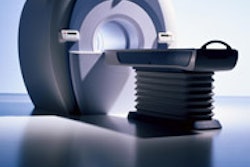NEW ORLEANS - Here's one reason why cardiologists and radiologists should at least collaborate on the interpretation of coronary CT angiography exams: These scans may reveal a greater number of major noncardiac findings than previously suspected.
And when making a pitch on behalf of radiologists at the American Heart Association scientific sessions, it's a good idea to bring data, as Dr. Irfan Shafique did this week.
In a study done at Johns Hopkins Bayview Medical Center in Baltimore, Shafique and colleagues found that 16% of scans performed for symptomatic coronary evaluations revealed a major noncardiac finding (Circulation, October 26, 2004, Vol. 110:17, Supplement III, p. 523, abstract 2453).
The study is an early attempt at establishing the prevalence of noncardiac findings on multislice CTA of the coronary arteries.
Previous studies with electron beam tomography (EBT) reported fewer noncardiac findings, which Shafique suggested was due to EBT's lower resolution -- and to screening exams of healthy patients rather than diagnoses of symptomatic ones.
In the Johns Hopkins study, "a significant percentage of patients referred for coronary evaluation had noncardiac findings, which either could explain the presenting symptoms or warrant further investigation," Shafique said. "Thus it is important that a radiologist review the entire scan."
The researchers looked at 75 patients with chest pain or known coronary artery disease who underwent coronary CTA at their facility.
The scans were performed using a 16-slice 400-msec rotation with images acquired in 0.5-mm or 1-mm slices. A cardiologist and radiologist reviewed the images within the cardiac CTA field-of-view in multiplanar reconstruction with lung and soft-tissue windows.
Nearly half the patients, 36 of 75, had noncoronary abnormalities on their scans. Twelve patients (16% of the 75) had what appeared to be major abnormalities, while the rest (33% of the 75) had minor abnormalities.
The major findings included two cases of pulmonary emboli, three lung masses, three of bulky lymphadenopathy, and three large hiatal hernias.
Shafique showed the AHA audience a number of images from the study, and shared corresponding details from the cases. In one example, he noted that the patient's reported chest discomfort was probably due to the large hiatal hernia visible on his scan.
He also described a cardiology colleague who wanted to excise some bothersome blobs that were blocking his evaluation of the coronaries on a 3D reconstruction. This prompted Shafique's rejoinder: "I wish we could do virtual resection of colon metastases."
All joking aside, Shafique said he believes cardiologists in practice at Johns Hopkins and elsewhere appreciate the value of radiological review, and that his study would reconfirm that value for others.
"These findings emphasize the need for collaboration between cardiologists and radiologists for optimal evaluation of CTA," Shafique concluded.
By Tracie L. Thompson
AuntMinnie.com staff writer
November 11, 2004
Related Reading
Radiologists (mostly) cheer as insurers set imaging rules, November 4, 2004
States, payors seek to stem tide of self-referral abuse, October 29, 2004
Even low-dose VC yields extracolonic findings, September 21, 2004
Breast screening could pull double duty for tracking heart disease, June 1, 2004
EBCT versus MDCT? It depends on the application, July 1, 2003
Copyright © 2004 AuntMinnie.com




















